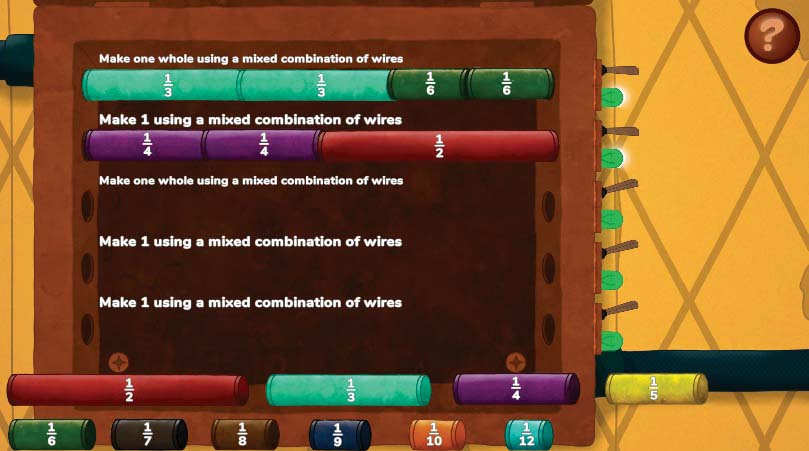Fiona Haniak-Cockeram, Su Lyn Corcoran and Sarah Lister
In this article, Fiona, Su, and Sarah provide a brief overview of a five-country Erasmus+ funded project. It developed digital resources to support teachers and learners to bridge the gap in digital, numeracy and literacy skills among refugee students in secondary schools across Europe and beyond. The project created various game-based learning resources, underpinned by content and language, that integrated learning pedagogical principles. The resources support and enhance the teaching and learning of an area of mathematics through a second language
Content and language integrated learning (CLIL)
The CLIL pedagogical approach involves teaching and learning activities that allow learners to develop new language as they learn new subject content. Essentially, it involves teaching this subject content through the medium of a second language that is not usually the main language of instruction. The dual-focused approach means an additional language is used for the teaching and learning of both content and language simultaneously. This can promote higher-order thinking skills such as problem-solving, reasoning, and creative thinking.
By adopting a CLIL pedagogy, teachers can exploit the connections between mathematics and language learning to help combat the language gap. Learners and educators have similar emotional responses to both subjects. Mathematics can provoke anxiety and negative attitudes in the same way as learning a second language. Learners often express how challenging these subjects are, and teachers can also lack confidence in their own ability and lack experience of teaching in increasingly diverse school contexts.
Increasingly, schools and teachers struggle to fully meet the diverse needs of learners from migrant backgrounds or those who do not have the language of instruction as their first language. This often results in learner disengagement, leading to poor or low attainment.
Game-based learning (GBL)
The project’s main objective was to use game-based learning to support learners to be more mathematically and linguistically literate. The games are for learners from migrant backgrounds, who do not speak the language used in school in their new country. Game-based resources can provide opportunities to consolidate and develop a greater knowledge and understanding of both mathematical concepts and numeracy skills. They also expose the learner to, and help them to practise using, the language of schooling for a purpose.
When the language of instruction differs from learners’ mother tongue, both learners and their teachers face challenges when engaging with and accessing subject content. This creates barriers to progress. Results from PISA 2015 highlight an attainment gap between learners from migrant backgrounds and their peers from non-migrant backgrounds. This gap is also affected by socioeconomic differences. Migrants – especially those forcibly displaced – often face the double disadvantage of coming from immigrant and disadvantaged backgrounds. Consequently, teachers need to reconsider and adapt their teaching strategies to fully address the needs of these learners and promote inclusion and inclusive practices.

The project
We wanted to find out how much game-based learning and CLIL could narrow the attainment gap – the ‘language’ gap and the ‘digital’ gap – for learners aged 12-13 years in each partner institution and country, for whom the language of instruction was not their first language. The project team comprised academics from Manchester Metropolitan University (UK), University of Cordoba (Spain), Vrije Universiteit Brussel (Belgium), Pedagogische Hochschule (Austria), and University of Turin (Italy). They worked together with designers from Emile Education to develop a series of innovative resources to help learners increase understanding, confidence, and competence in mathematics and language.
The three-year project involved collaboration with school teachers in the five countries. Virtual and face-to-face seminars, workshops, and training events informed the design of the materials. We chose to develop game-based learning resources to deepen learners’ conceptual understanding of fractions, which learners often find difficult. We also wanted learners to engage with technology in a classroom context, to promote equitable access to this technology, help develop their digital literacy competencies, and narrow the ‘digital’ gap.
We also developed a series of training materials to support teachers and trainee teachers when introducing the games and associated pedagogies. In December 2021, we held the first virtual training sessions, hosted by Manchester Metropolitan University. In 2022 we will deliver several free online events for teachers interested in knowing more about CLIL and game-based learning.
The resources
The main resource is an app called Fractio-Quest. It comprises six games, in five languages, that focus on fractions. When playing computer-based games, learners are practising and applying 21st century skills that can be applied in the real world. The learning that takes place does not simply involve acquiring knowledge and content. Rather, game-based resources offer a different way to engage and interact with subject content, promoting different ways of thinking and inspiring creativity, interest, and social interaction.
The problem-solving elements embedded within the games, alongside a narrative thread, require learners to engage with a series of challenges or quests where they assess situations, analyse information, make decisions, and choose a course of action. They respond to the consequences of their actions in order to progress through the different stages of the game, all of which are key to cognitive development.
The project team also developed a digital portfolio of supplementary resources that can be used alongside the six games, or on their own. These online resources provide game-based activities about using fractions. At the time of writing, the English set is complete and the translations are being finalised. They should all be available to use from March 2022.
You can find out more about the project and how to access the app at: https://bit.ly/EER10-10 and https://bit.ly/EER10-9. Information about the supplementary resources will be included on these website pages when finalised.
Fiona, Su and Sarah all work in the Faculty of Health and Education at Manchester Metropolitan University. They can be contacted through the project email:
framingclil@gmail.com or via the EENET office.